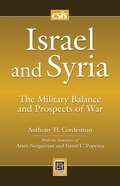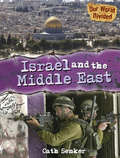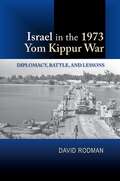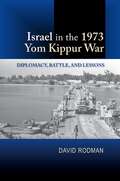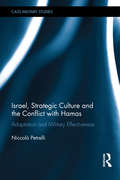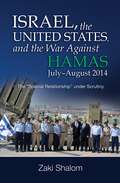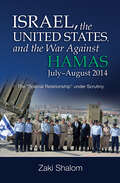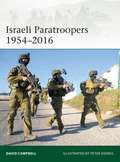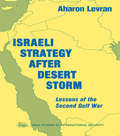- Table View
- List View
Israel and Syria: The Military Balance and Prospects of War (Praeger Security International)
by Anthony H. Cordesman Aram Nerguizian Inout C. PopescuIsrael and Syria: The Military Balance and Prospects of War provides a detailed and current picture of the military capabilities of Israel and Syria, reflecting the changes and lessons of the Israel-Hezbollah War in 2006 and other recent conflicts. It offers extensive analysis, supported by tables and charts, on the trends in military spending, arms imports and technology transfers, military manpower, weapons, and orders of battle. By going beyond military balance analysis, Cordesman examines the probable nature and results of a future war and how the readiness, capability, tactics, and technology on each side would shape its outcome.Israel and Syria: The Military Balance and Prospects of War shows how a dangerous new conflict between both nations would cripple all strides in strategic gains and Israeli-Syrian diplomacy. On the other hand, peace negotiations would offer a safer, more productive relationship. Israel and Syria need to consider the true nature of their military balance and the undermining effect to both nations as well as the costs and risks of any future conflict. Although Syria does retain important options in terms of asymmetric and proxy conflicts, it would fail in its attempt to recapture the Golan. While Israel would almost certainly win a future war, it cannot make gains from acquiring more Syrian territory and a new war would create major problems with its neighbors and in dealing with the Palestinians.The risk of a new Israeli-Syrian conflict is so serious that both sides need to understand the true nature of their military balance, and the costs and risks of any future conflict. Israel and Syria: The Military Balance and Prospects of War shows how dangerous a new conflict could be, that neither side can make lasting strategic gains from a future conflict, and that peace negotiations offer a far safer and more productive option. It provides a detailed and current picture of the military capabilities of Israel and Syria, reflecting the changes and lessons of the Israel-Hezbollah War in 2006 and other recent conflicts. Israel and Syria: The Military Balance and Prospects of War provides extensive analysis, supported by tables and charts, on the trends in military spending, arms imports and technology transfers, military manpower, weapons, and orders of battle. By going beyond military balance analysis, Cordesman examines the probable nature and results of a future war and how the readiness, capability, tactics, and technology on each side would shape its outcome.
Israel and the Gaza Strip: The First Decade 1947–1957 (Routledge Studies in Middle Eastern Politics)
by Arnon GolanThis book concentrates on the formative period of the Gaza Strip and the bordering Israeli Gaza Frontier Area, considering them as a distinct geographic region that might best be understood as an integral unit of analysis.Based on abundant Israeli, British and American documentation, articles from the contemporary Arab press and other sources that reflect Arab perspectives, the book deals with the formation of the Gaza Strip between the initial drawing of the boundaries of the 1947 UN partition plan until the Israeli withdrawal from the area in March 1957, following the 1956 War. It also concentrates on the development of the Israeli urban and rural settlement systems that enveloped the Gaza Strip and formed the Gaza Frontier Area. Ultimately, the book provides a wider understanding of the history of the Arab-Israeli conflict, shedding light on political, military and demographic-spatial plans to solve the Gaza Strip abnormality that involved radical measures such as mass population transfers.The innovative historical-geographical approach of the research offers key insights into the politics of the region, and the book will be of particular interest to anyone studying the history and development of the Arab-Israeli conflict.
Israel and the Gaza Strip: The First Decade 1947–1957 (Routledge Studies in Middle Eastern Politics)
by Arnon GolanThis book concentrates on the formative period of the Gaza Strip and the bordering Israeli Gaza Frontier Area, considering them as a distinct geographic region that might best be understood as an integral unit of analysis.Based on abundant Israeli, British and American documentation, articles from the contemporary Arab press and other sources that reflect Arab perspectives, the book deals with the formation of the Gaza Strip between the initial drawing of the boundaries of the 1947 UN partition plan until the Israeli withdrawal from the area in March 1957, following the 1956 War. It also concentrates on the development of the Israeli urban and rural settlement systems that enveloped the Gaza Strip and formed the Gaza Frontier Area. Ultimately, the book provides a wider understanding of the history of the Arab-Israeli conflict, shedding light on political, military and demographic-spatial plans to solve the Gaza Strip abnormality that involved radical measures such as mass population transfers.The innovative historical-geographical approach of the research offers key insights into the politics of the region, and the book will be of particular interest to anyone studying the history and development of the Arab-Israeli conflict.
Israel and the Middle East: Israel And The Middle East (Our World Divided)
by Cath SenkerThe background, history and key events of conflicts in Israel and the Middle East are presented. Different opinions, including views found in the media, are explored alongside factual accounts of events. Readers are encouraged to think about their own views and discuss controversial topics.
Israel in the 1973 Yom Kippur War: Diplomacy, Battle and Lessons
by David RodmanThe State of Israel faced one of its most difficult challenges during the 1973 Yom Kippur War. Though the Israel Defense Forces (IDF) eventually emerged as the clear victor in the war, it suffered serious reverses at the outset of hostilities, as well as substantial losses in men and equipment. This book revisits the Yom Kippur War by exploring a number of issues that have not previously received the attention they deserve or that would benefit from a fresh evaluation. Among the issues examined are: the American-Israeli and Jordanian-Israeli relationships during the war; the roles of Israeli nuclear weapons and airpower; the IDF's practice of combined arms warfare; the reasons why the IDF turned the tide of the war more quickly on the Golan front than on the Sinai front; the impact of American arms transfers; and the lessons derived from the war by the United States Army and the IDF. This book, which relies heavily on government documents and other primary sources of information, fills important descriptive and analytical gaps in the academic literature about the Yom Kippur War. No other book compares to it in respect of content and interpretation. It is, in short, essential reading for all scholars interested in the diplomatic and military dimensions of the war.
Israel in the 1973 Yom Kippur War: Diplomacy, Battle and Lessons
by David RodmanThe State of Israel faced one of its most difficult challenges during the 1973 Yom Kippur War. Though the Israel Defense Forces (IDF) eventually emerged as the clear victor in the war, it suffered serious reverses at the outset of hostilities, as well as substantial losses in men and equipment. This book revisits the Yom Kippur War by exploring a number of issues that have not previously received the attention they deserve or that would benefit from a fresh evaluation. Among the issues examined are: the American-Israeli and Jordanian-Israeli relationships during the war; the roles of Israeli nuclear weapons and airpower; the IDF's practice of combined arms warfare; the reasons why the IDF turned the tide of the war more quickly on the Golan front than on the Sinai front; the impact of American arms transfers; and the lessons derived from the war by the United States Army and the IDF. This book, which relies heavily on government documents and other primary sources of information, fills important descriptive and analytical gaps in the academic literature about the Yom Kippur War. No other book compares to it in respect of content and interpretation. It is, in short, essential reading for all scholars interested in the diplomatic and military dimensions of the war.
Israel, Strategic Culture and the Conflict with Hamas: Adaptation and Military Effectiveness (Cass Military Studies)
by Niccolò PetrelliThis book offers a comprehensive overview of the impact of ‘strategic culture’ on Israeli military operations against Hamas between 1987 and 2014. It has often been argued that Israeli policies and military operations against Hamas have proven tactically effective, but strategically disastrous, allowing the Islamic Resistance Movement to grow from a small spin-off of the Muslim Brotherhood into a powerful military and political actor in the Palestinian arena. This book argues, contrary to this opinion, that Israel was effective in its struggle against the Islamic Resistance Movement between 1987 and 2014, as the Jewish state ultimately managed to deny the majority of Hamas' strategic aims and to preserve a position of relative strength. By relying on a synthesis of primary sources, interviews, memoirs, scholarly and professional military studies and information gathered from the media, the study delivers a careful and comprehensive analysis of the conflict. It provides an historical outline of the development of the Israeli ‘strategic culture’ and analyzes its impact on the process of military adaptation during the First Intifada, the Oslo Peace Process, the al-Aqsa Intifada and the Gaza wars. Finally, the book illuminates how the Israeli strategic culture moulded a distinctive ‘way of war’ that, though marked by successes and failures, ultimately proved effective against Hamas. This book will be of much interest to students of strategic studies, Middle Eastern politics, counter-insurgency, counter-terrorism and security studies in general.
Israel, Strategic Culture and the Conflict with Hamas: Adaptation and Military Effectiveness (Cass Military Studies)
by Niccolò PetrelliThis book offers a comprehensive overview of the impact of ‘strategic culture’ on Israeli military operations against Hamas between 1987 and 2014. It has often been argued that Israeli policies and military operations against Hamas have proven tactically effective, but strategically disastrous, allowing the Islamic Resistance Movement to grow from a small spin-off of the Muslim Brotherhood into a powerful military and political actor in the Palestinian arena. This book argues, contrary to this opinion, that Israel was effective in its struggle against the Islamic Resistance Movement between 1987 and 2014, as the Jewish state ultimately managed to deny the majority of Hamas' strategic aims and to preserve a position of relative strength. By relying on a synthesis of primary sources, interviews, memoirs, scholarly and professional military studies and information gathered from the media, the study delivers a careful and comprehensive analysis of the conflict. It provides an historical outline of the development of the Israeli ‘strategic culture’ and analyzes its impact on the process of military adaptation during the First Intifada, the Oslo Peace Process, the al-Aqsa Intifada and the Gaza wars. Finally, the book illuminates how the Israeli strategic culture moulded a distinctive ‘way of war’ that, though marked by successes and failures, ultimately proved effective against Hamas. This book will be of much interest to students of strategic studies, Middle Eastern politics, counter-insurgency, counter-terrorism and security studies in general.
Israel, the United States, and the War Against Hamas, July-August 2014: The Special Relationship under Scrutiny
by Professor Zaki ShalomOperation Protective Edge, launched on July 8, 2014, saw heavy fighting between the Israel Defense Forces and Hamas in Gaza. Throughout the war US government media spokespersons confirmed Israels right to self-defense against rockets and tunnels, and condemned Hamas for initiating the conflict and its use of human shields. But there is an important difference between confirmation and pro-active demonstration at the highest political level. The longstanding alliance between the United States and Israel has always been subject to the administration and president of the day. In this case, the Obama administrations support for Israels right to self-defense was qualified, and as a result the Israeli political leadership felt constrained in its ability to defeat Hamas militarily without risking criticism from the United States that would impact negatively on the special relationship. In its role as ally, the United States was careful not to apply direct political pressure on Israel. However, US government public criticisms relating to Gazan civilian loss of life damaged Israel on the international stage via harrowing media coverage surrounding the conflict. The Federal Aviation Administration order to airlines to stop flying to Israel enhanced Hamas claim that it had inflicted a strategic defeat to the Zionist State. For the last 70 years Israel has recognized that the United States is its primary strategic ally a principle initiated by Israels first Prime Minister and Defense Minister, David Ben-Gurion. Political and military policies have to be directed to prevent a rift. But the Protective Edge experience has brought to the fore that in times of crisis Israel cannot rely on a special relationship to secure its safety and must of necessity possess the political will and military ability to defend itself and to take actions that may result in a strained relationship.
Israel, the United States, and the War Against Hamas, July-August 2014: The Special Relationship under Scrutiny
by Professor Zaki ShalomOperation Protective Edge, launched on July 8, 2014, saw heavy fighting between the Israel Defense Forces and Hamas in Gaza. Throughout the war US government media spokespersons confirmed Israels right to self-defense against rockets and tunnels, and condemned Hamas for initiating the conflict and its use of human shields. But there is an important difference between confirmation and pro-active demonstration at the highest political level. The longstanding alliance between the United States and Israel has always been subject to the administration and president of the day. In this case, the Obama administrations support for Israels right to self-defense was qualified, and as a result the Israeli political leadership felt constrained in its ability to defeat Hamas militarily without risking criticism from the United States that would impact negatively on the special relationship. In its role as ally, the United States was careful not to apply direct political pressure on Israel. However, US government public criticisms relating to Gazan civilian loss of life damaged Israel on the international stage via harrowing media coverage surrounding the conflict. The Federal Aviation Administration order to airlines to stop flying to Israel enhanced Hamas claim that it had inflicted a strategic defeat to the Zionist State. For the last 70 years Israel has recognized that the United States is its primary strategic ally a principle initiated by Israels first Prime Minister and Defense Minister, David Ben-Gurion. Political and military policies have to be directed to prevent a rift. But the Protective Edge experience has brought to the fore that in times of crisis Israel cannot rely on a special relationship to secure its safety and must of necessity possess the political will and military ability to defend itself and to take actions that may result in a strained relationship.
Israeli A-4 Skyhawk Units in Combat (Combat Aircraft #81)
by Jim Laurier Shlomo AloniThe light and agile A-4 Skyhawk was the first modern American jet to be offered to the Israeli Air Force, marking the point where the US took over from France as Israel's chief military supplier. Deliveries began too late for the A-4 to fight in the Six-Day War, but it soon formed the backbone of the IAF's ground-attack force. From 1969 to 1970 it flew endless sorties against Egyptian forces in the War of Attrition. Then, during the Yom Kippur War, five squadrons of A-4s saw combat and 50 planes were lost as they battled against the Arab armored onslaught. Using previously unpublished first-hand accounts and rare photography from the IAF archives and pilots' private collections, Shlomo Aloni tells the definitive history of the IAF's A-4 squadrons, including the story of Ezra "BABAN†? Dotan who became an ace with an unique double-kill of MiG17s.
Israeli A-4 Skyhawk Units in Combat (Combat Aircraft #81)
by Jim Laurier Shlomo AloniThe light and agile A-4 Skyhawk was the first modern American jet to be offered to the Israeli Air Force, marking the point where the US took over from France as Israel's chief military supplier. Deliveries began too late for the A-4 to fight in the Six-Day War, but it soon formed the backbone of the IAF's ground-attack force. From 1969 to 1970 it flew endless sorties against Egyptian forces in the War of Attrition. Then, during the Yom Kippur War, five squadrons of A-4s saw combat and 50 planes were lost as they battled against the Arab armored onslaught. Using previously unpublished first-hand accounts and rare photography from the IAF archives and pilots' private collections, Shlomo Aloni tells the definitive history of the IAF's A-4 squadrons, including the story of Ezra "BABAN†? Dotan who became an ace with an unique double-kill of MiG17s.
Israeli F-15 Eagle Units in Combat (Combat Aircraft)
by Shlomo Aloni Chris DaveyPost-Yom Kippur War, Israel purchased the F-15 Eagle, the then world's best air-to-air fighter, in an effort to prevent another surprise attack from the air. For the first time in its history the IDF/AF operated a fighter that was a full generation ahead of opposing interceptors in the region. The first 'kill' F-15 Baz (Buzzard) arrived in Israel in 1976 and soon proved its worth in combat. Israeli Baz pilots were credited with 12.5 kills between 1979 and 1981, with 33 victories following during the June 1982 Lebanon War. Despite substantial combat, no Israeli F-15 has ever been lost to enemy action. In the 1990s the US government supplied the IDF/AF with the F-15I Ra'am (Thunder) to fulfill the long-range surface-to-surface missile mission post-Desert Storm. From A to I, the extremely capable, and combat-tested, Israeli F-15 force will continue to deter potential enemies well into the foreseeable future. This book examines the history and development of these units.
Israeli F-15 Eagle Units in Combat (Combat Aircraft #67)
by Shlomo Aloni Mr Chris DaveyPost-Yom Kippur War, Israel purchased the F-15 Eagle, the then world's best air-to-air fighter, in an effort to prevent another surprise attack from the air. For the first time in its history the IDF/AF operated a fighter that was a full generation ahead of opposing interceptors in the region. The first 'kill' F-15 Baz (Buzzard) arrived in Israel in 1976 and soon proved its worth in combat. Israeli Baz pilots were credited with 12.5 kills between 1979 and 1981, with 33 victories following during the June 1982 Lebanon War. Despite substantial combat, no Israeli F-15 has ever been lost to enemy action. In the 1990s the US government supplied the IDF/AF with the F-15I Ra'am (Thunder) to fulfill the long-range surface-to-surface missile mission post-Desert Storm. From A to I, the extremely capable, and combat-tested, Israeli F-15 force will continue to deter potential enemies well into the foreseeable future. This book examines the history and development of these units.
Israeli F-4 Phantom II Aces (Aircraft of the Aces)
by Jim Laurier Shlomo AloniThe American manufactured F-4 Phantom II was used by the Israelis in air-to-ground missions, as an attack aircraft, and air-to-air missions as a fighter. Despite performing both roles with equal success the Israeli reliance on the Mirage III and Nesher delta fighters meant that the F-4 was used most regularly in its air-to-ground role. The kill total of the Israeli F-4 community was, consequently, a modest 116.5; significantly lower than that of other Israeli aircraft types in service between 1969 and 1982. A handful of aces were, nevertheless, created and, using first hand accounts, this unique book tells their stories. Many F-4 pilots had previously flown the Mirage III but most of the navigators were either inexperienced flying school graduates or had been transferred from transport aircraft. The decision to create such teams may have appeared an odd one and it certainly led to a number of interesting experiences but proved, ultimately, to be so successful that by 2010 the Israeli air force will have more two-seat combat aircraft than single-seat fighters. The F-4 experience was, therefore, crucial to moulding the future of the Israeli air force.
Israeli F-4 Phantom II Aces (Aircraft of the Aces)
by Jim Laurier Shlomo AloniThe American manufactured F-4 Phantom II was used by the Israelis in air-to-ground missions, as an attack aircraft, and air-to-air missions as a fighter. Despite performing both roles with equal success the Israeli reliance on the Mirage III and Nesher delta fighters meant that the F-4 was used most regularly in its air-to-ground role. The kill total of the Israeli F-4 community was, consequently, a modest 116.5; significantly lower than that of other Israeli aircraft types in service between 1969 and 1982. A handful of aces were, nevertheless, created and, using first hand accounts, this unique book tells their stories. Many F-4 pilots had previously flown the Mirage III but most of the navigators were either inexperienced flying school graduates or had been transferred from transport aircraft. The decision to create such teams may have appeared an odd one and it certainly led to a number of interesting experiences but proved, ultimately, to be so successful that by 2010 the Israeli air force will have more two-seat combat aircraft than single-seat fighters. The F-4 experience was, therefore, crucial to moulding the future of the Israeli air force.
The Israeli Military and the Origins of the 1967 War: Government, Armed Forces and Defence Policy 1963–67 (Middle Eastern Military Studies)
by Ami GluskaThis new book looks at the relationship between the Israeli armed forces, the government, and the origins of the 1967 War. Ami Gluska discusses the effect of the Israel Defense Forces (IDF) on Israel’s defense policy between 1963-1967 against the backdrop of the developments in the Middle East. In addition, he describes in detail the decision-making process leading to the Arab-Israeli Six Day War in June 1967 through the prism of the relations between the military and political echelons. He shows how the Six Day War was a watershed event in the Middle-Eastern conflict and had a profound effect on the development of the Palestinian problem and the character of the State of Israel over the past four decades. This book will be of great interest to students of Middle Eastern politics, strategic studies, Israeli politics and military history in general.
The Israeli Military and the Origins of the 1967 War: Government, Armed Forces and Defence Policy 1963–67 (Middle Eastern Military Studies)
by Ami GluskaThis new book looks at the relationship between the Israeli armed forces, the government, and the origins of the 1967 War. Ami Gluska discusses the effect of the Israel Defense Forces (IDF) on Israel’s defense policy between 1963-1967 against the backdrop of the developments in the Middle East. In addition, he describes in detail the decision-making process leading to the Arab-Israeli Six Day War in June 1967 through the prism of the relations between the military and political echelons. He shows how the Six Day War was a watershed event in the Middle-Eastern conflict and had a profound effect on the development of the Palestinian problem and the character of the State of Israel over the past four decades. This book will be of great interest to students of Middle Eastern politics, strategic studies, Israeli politics and military history in general.
Israeli Mirage III and Nesher Aces (Aircraft of the Aces)
by Shlomo Aloni Mark StylingIsraeli delta fighters pilots have been credited with almost 300 kills between 1966 and 1974, and dozens of them became aces. The Israeli aerial kill exchange rate and overall air-to-air performance was phenomenal. Although the Israeli pilots were flying Mach 2 fighters, they lacked any modern radar equipment and their MiG-21 flying opponents should have had a performance edge over them. This book details their most signifcant engagements, many of which were essentially World War 2 style dogfights fought with jet aircraft. Because neither side had the combat edge to disengage at will most engagements were a life and death struggle and the introduction of air-to-air missiles and the Israeli Nesher was to prove decisive in this theatre.
Israeli Mirage III and Nesher Aces (Aircraft of the Aces #59)
by Shlomo Aloni Mark StylingIsraeli delta fighters pilots have been credited with almost 300 kills between 1966 and 1974, and dozens of them became aces. The Israeli aerial kill exchange rate and overall air-to-air performance was phenomenal. Although the Israeli pilots were flying Mach 2 fighters, they lacked any modern radar equipment and their MiG-21 flying opponents should have had a performance edge over them. This book details their most signifcant engagements, many of which were essentially World War 2 style dogfights fought with jet aircraft. Because neither side had the combat edge to disengage at will most engagements were a life and death struggle and the introduction of air-to-air missiles and the Israeli Nesher was to prove decisive in this theatre.
Israeli Paratroopers 1954–2016 (Elite)
by Peter Dennis David CampbellFrom the creation of the first volunteer paratroop unit shortly after the birth of Israel and of the Israeli Defense Force, this arm of service has been recognized as elite. They have also been the first choice for daring special missions, and it is mainly from their ranks that Israel's Special Forces units have been recruited. A unique aspect of the Israeli military is the cross-posting of officers from the airborne, armoured and other units, to ensure that all unit commanders share their aggressive qualities and thorough understanding of the capabilities of all arms. In this way the influence of the paratroop arm has been out of proportion to its size. This fully illustrated study is a complete history of Israeli paratroopers from its creation to the present day, including relevant developments in their role and organization, as well as their achievements and setbacks in conflicts such as the Six Days War and Yom Kippur War.
Israeli Paratroopers 1954–2016 (Elite)
by Peter Dennis Mr David CampbellFrom the creation of the first volunteer paratroop unit shortly after the birth of Israel and of the Israeli Defense Force, this arm of service has been recognized as elite. They have also been the first choice for daring special missions, and it is mainly from their ranks that Israel's Special Forces units have been recruited. A unique aspect of the Israeli military is the cross-posting of officers from the airborne, armoured and other units, to ensure that all unit commanders share their aggressive qualities and thorough understanding of the capabilities of all arms. In this way the influence of the paratroop arm has been out of proportion to its size. This fully illustrated study is a complete history of Israeli paratroopers from its creation to the present day, including relevant developments in their role and organization, as well as their achievements and setbacks in conflicts such as the Six Days War and Yom Kippur War.
Israeli Soldier vs Syrian Soldier: Golan Heights 1967–73 (Combat #18)
by Johnny Shumate David CampbellIsrael seized the strategically critical Golan Heights from Syria during the 1967 Six Day War in an audacious and determined operation, yet when the Yom Kippur War broke out the Israeli military were exposed by the effectiveness of the newly confident and dangerous Syrian army. In the Golan only luck, herculean Israeli efforts and tactical misjudgements by the Syrians were to allow the Israelis to maintain control. In this book, three pivotal encounters in the Golan are assessed, supported by artwork, maps and photographs, tracking how both sides' forces evolved over the period.
Israeli Soldier vs Syrian Soldier: Golan Heights 1967–73 (Combat #18)
by Johnny Shumate Mr David CampbellIsrael seized the strategically critical Golan Heights from Syria during the 1967 Six Day War in an audacious and determined operation, yet when the Yom Kippur War broke out the Israeli military were exposed by the effectiveness of the newly confident and dangerous Syrian army. In the Golan only luck, herculean Israeli efforts and tactical misjudgements by the Syrians were to allow the Israelis to maintain control. In this book, three pivotal encounters in the Golan are assessed, supported by artwork, maps and photographs, tracking how both sides' forces evolved over the period.
Israeli Strategy After Desert Storm: Lessons of the Second Gulf War
by Aharon LevranIraq's invasion of Kuwait and the Gulf War had a traumatic effect on the Middle East and its implications were particularly serious for Israel, which felt obliged to reassess its strategic and military perspectives. This is an examination of the lessons that the Gulf War holds for Israel.
